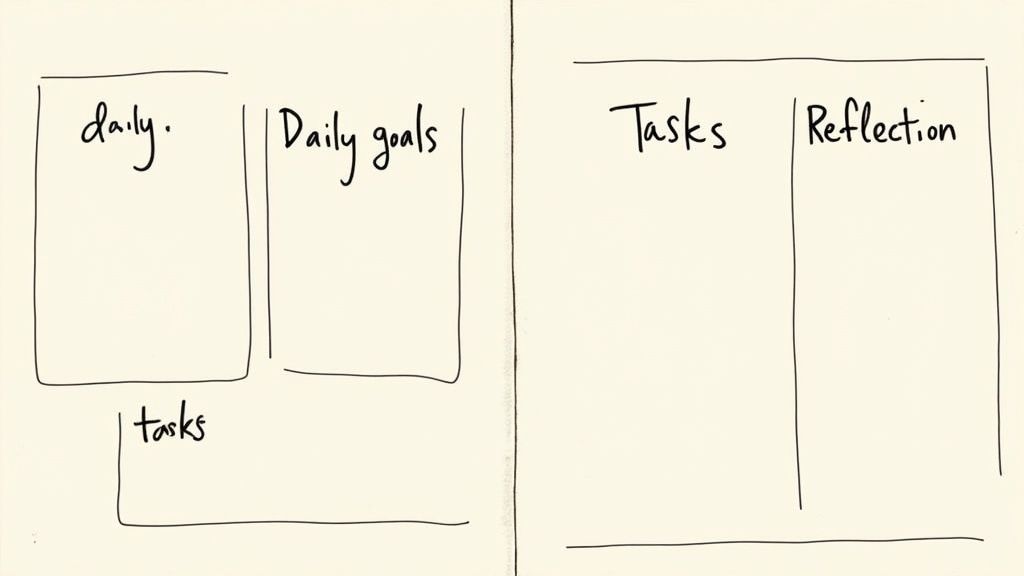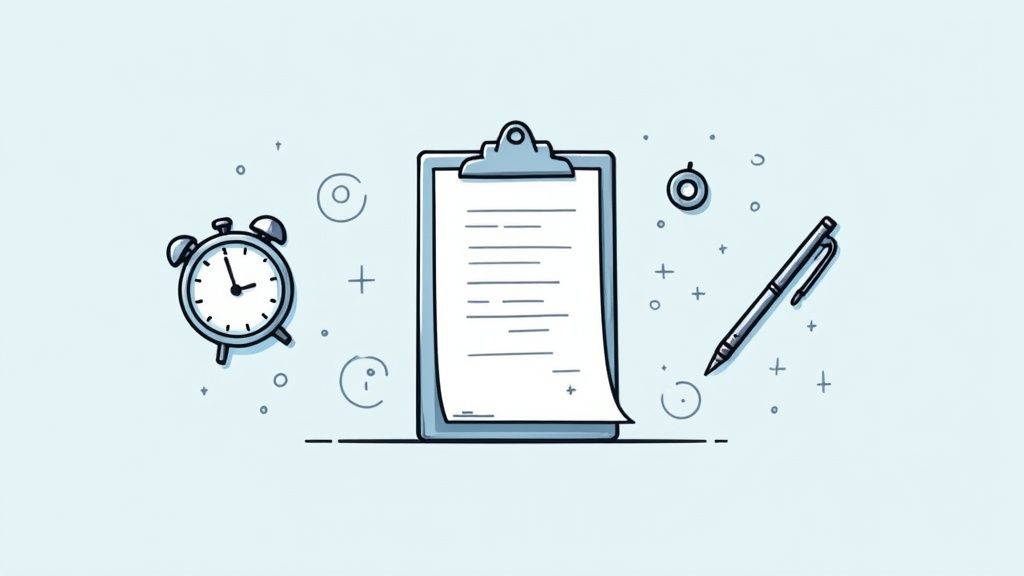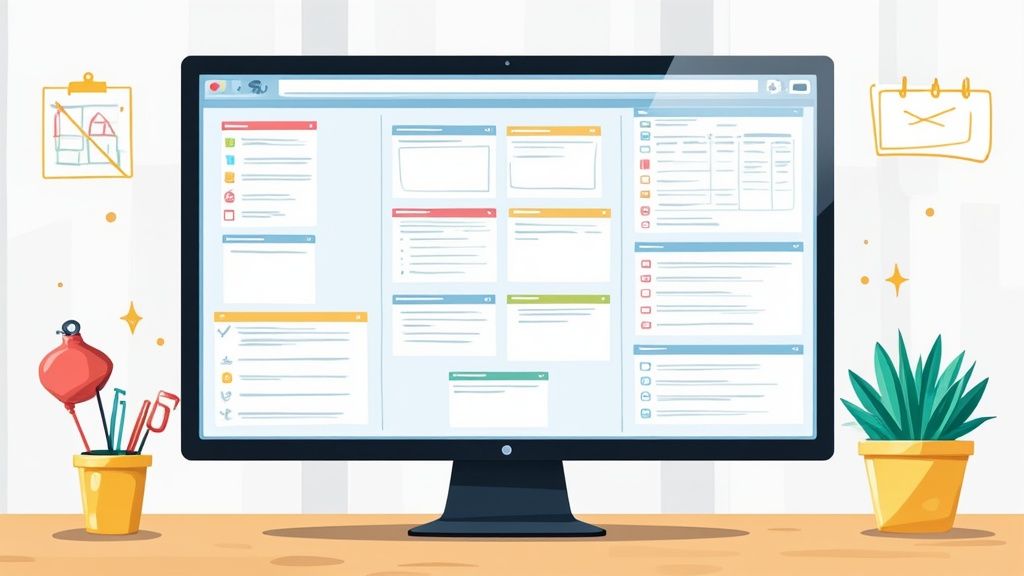The Ultimate Guide to Obsidian Daily Notes Template: Proven Strategies That Drive Better Results
Transform your personal knowledge management with battle-tested strategies for Obsidian daily notes templates. Learn expert approaches to creating, customizing, and automating templates that boost your productivity. meta t: The Ultimate Guide to Obsidian Daily Notes Template: Proven Strategies That Drive Better Results published: No slug: ultimate-guide-obsidian-daily-notes-template-strategies
Building Your Knowledge Foundation with Daily Notes
Daily notes in Obsidian help professionals create organized knowledge systems. These notes form the backbone of an effective "second brain," letting you capture fleeting thoughts and build connections between ideas. Unlike traditional notebooks where thoughts get lost between pages, Obsidian's daily notes provide a clear timeline for tracking and connecting your ideas over time. This makes it much easier to find that random thought from your morning commute when working on a project weeks later.
The Power of the Daily Note Structure
Daily notes work like digital journals, with each note dedicated to a single day. This gives you a consistent space to record your thoughts, tasks, and insights as they happen. The daily format helps build strong note-taking habits since you always know where to put new information. Instead of scattering notes across different apps and devices, everything lives in one searchable timeline.
Making the Most of Obsidian's Features
Daily notes do much more than just capture thoughts. You can connect them with other productivity tools to track progress on goals, manage projects, and build knowledge over time. For example, you might log your daily writing progress, exercise routine, and business ideas all in one place. This saves time and mental energy since you're not constantly switching between apps. The ability to link daily notes to other files also helps you spot patterns and connections in your thinking.
Addressing Common Challenges and Ensuring Consistency
A key challenge with daily notes is keeping them useful and accurate over time. The Obsidian community has developed several ways to handle common issues. For instance, using a dateOfTemplateInstanciation property in the frontmatter helps keep dates static for each note. Your daily note system should grow with your needs - whether that means adding new sections, changing how you track information, or trying different plugins. The goal is building note-taking habits that serve you well for years to come.

Creating Your First Obsidian Daily Notes Template That Actually Works
A well-designed daily notes template can make your Obsidian workflow smoother and more effective. By following proven practices from experienced users, you can build a template that matches your needs while maintaining consistency in your note-taking.
Essential Components of a Daily Note
Think of your daily note as your command center - a place where you track activities, capture thoughts, and reflect on your day. Most effective templates include:
Date and Day: Start with clear date formatting for easy reference and search
Morning Routine/Planning: Space to list your key tasks and set intentions for the day
Daily Log: The main section for meeting notes, updates, ideas, and observations
Evening Reflection: Time to review accomplishments and lessons learned
Structuring Your Template for Flexibility and Consistency
Your template should provide enough structure to stay organized while remaining flexible enough to adapt to each day's needs. Use clear headings to separate sections and bullet points for lists and tasks. The goal is to create a format that supports your workflow rather than restricting it.
For instance, if you manage projects, add dedicated sections for status updates. Writers might include brainstorming spaces. Obsidian lets you customize the format to match how you actually work.
Examples and Expert Insights
Study how experienced users structure their daily notes for inspiration. Pay attention to their section organization, information capture methods, and plugin choices. Take what works and modify it for your specific needs.
The Templater plugin can automatically generate your daily notes with your chosen template. This ensures consistency and saves time. Learn more about creating effective templates here.
Step-by-Step Template Creation
Create a New Note: Make a new note called "Daily Note Template"
Add Your Sections: Include the core components with clear headings
Customize: Adjust sections and formatting to match your needs
Save Your Template: Store it in a dedicated Templates folder
Configure Daily Notes Plugin: Set up the plugin to use your template
Progressive Improvement: The Key to Long-Term Success
Start with a basic template and refine it based on actual use. Notice which sections you use most, what's missing, and what could work better. This gradual refinement helps build a template that truly serves your needs and becomes a natural part of your daily workflow.

Keep testing and adjusting your template over time. The goal is to create something that enhances your productivity without feeling like extra work. A template that grows with you will become an essential tool for managing information and staying organized.
Maximizing Template Power Through Essential Plugins
A basic daily notes template in Obsidian works well on its own, but adding carefully chosen plugins can make it much more capable. Let's look at how specific plugins can help automate your workflow, link your ideas, and turn your daily notes into an effective planning tool.
Automating Your Workflow With Templater
The Templater plugin saves time by handling repetitive tasks in your daily notes. You can use it to automatically:
Insert today's date and other dynamic content
Add pre-defined task lists and schedules
Pull in relevant information from other notes
This automation lets you focus on the actual work instead of manual setup each day. For example, you could have Templater automatically create your daily schedule and add any recurring tasks right when you open a new daily note.
Connecting Your Thoughts With Dataview
Dataview turns your notes into a searchable database. This plugin lets you create dynamic lists and tables by querying your notes based on:
Tags and metadata
Note content
Custom criteria
You might use it to automatically gather all notes about a specific project or track progress on goals across multiple daily entries. This connected view helps spot patterns and insights you might otherwise miss.
Enhancing Your Daily Notes With Journals
The Journals plugin makes it easy to manage daily notes over time. It provides:
Simple navigation between days/weeks/months
Custom calendar views
Quick access to past entries
These features help maintain a consistent journaling practice and make it easier to review your progress and reflections.
Integrating Plugins for a Powerful System
The real benefits come from combining plugins thoughtfully. For instance:
Use Templater to insert a Dataview query
Have that query pull in today's tagged tasks
Use Journals to review completed tasks from previous days
This creates a smooth workflow from planning to review while keeping everything connected.
Navigating Potential Pitfalls
While plugins are helpful, it's important to avoid common issues:
Start simple - Add plugins gradually as needed
Watch for template bloat that reduces flexibility
Monitor performance impact from multiple plugins
Regularly review which plugins you actually use
Keep your setup lean and focused on what truly helps your workflow.

Advanced Customization Strategies That Scale
Your Obsidian daily notes can grow into a robust system that adapts to your changing needs. By thoughtfully adding features like habit tracking, mood monitoring, and project management, you'll create a personalized command center for your daily work and personal growth.
Building Adaptable Templates
Think of your daily notes template as a modular system - you have core elements that stay consistent, plus optional sections you can add or remove based on what each day requires. For instance, you might include a "Client Projects" section only on workdays, while keeping your daily review and gratitude sections as permanent fixtures.
This flexibility lets you maintain structure while accommodating different contexts like work, personal projects, and special events. The key is striking the right balance between consistency and adaptability.
Integrating Habit Tracking and Mood Monitoring
Adding habit tracking directly into your daily notes helps you spot patterns and stay accountable. A simple table works well for tracking daily habits:
Exercise
✅
❌
✅
✅
❌
✅
✅
Meditation
✅
✅
❌
✅
❌
❌
✅
Journaling
✅
✅
✅
✅
✅
❌
✅
Consider adding a quick 1-5 mood rating as well. Having this data right in your daily notes makes it easy to review trends and identify what impacts your wellbeing and productivity.
Incorporating Project Management
Turn your daily notes into a lightweight project tracker by adding dedicated sections for active projects. For each project, include:
Key Tasks: Focus on 2-3 priority items for the day
Progress Notes: Brief updates on what you accomplished
Next Steps: Quick plan for tomorrow's work
This approach connects your daily work directly to bigger project goals while keeping everything organized in one place.
Data Visualization and Automation for Enhanced Productivity
As your collection of notes grows, data visualization becomes incredibly useful. The Dataview plugin lets you create custom views of your notes - like graphs showing habit consistency or tables summarizing project hours. Pair this with the Templater plugin to automate repetitive parts of your daily note setup.
Keep refining your template based on what actually helps you work better. The most effective systems grow naturally from real use rather than theoretical perfection. Pay attention to which sections you use most and adjust accordingly.
Building a Focused System with Daily Notes Templates
A well-designed Obsidian daily notes template is your foundation for effective personal knowledge management. Instead of just logging activities, your template can unite your daily tasks, ongoing projects, and bigger goals in one organized system. The key is establishing routines that minimize mental overhead and promote concentrated work.
Linking Daily Work to Big-Picture Goals
Think of your daily notes as a map connecting each day's tasks to your larger objectives. Rather than making simple to-do lists, organize tasks by project to give them clear purpose. Include a quick reflection space to note how today's accomplishments move you closer to key goals. This helps maintain focus on what matters most.
Setting Up for Deep Work Sessions
Your daily notes template can prepare you for productive focus time. Start by identifying your 2-3 most important tasks for the day. Use these as starting points for dedicated work blocks, helping you avoid constant task-switching and find your flow more easily.
Integrating Project Management
Keep project details right in your daily notes instead of separate tools. Add sections to track progress, note obstacles, and plan next steps. For example, an author could log word count, outline upcoming chapters, and capture story ideas all in one place. This unified approach prevents scattered information and builds momentum.
Creating Sustainable Daily Routines
The most effective system is one you'll actually use long-term. Begin with a basic template and refine it gradually based on your real needs. As noted by experienced Obsidian user Dann Berg, he built his template over several months through small experiments. This step-by-step method leads to a natural workflow that sticks. Focus on simplicity - your template should reduce friction, not add complexity. Regular reviews help ensure it remains helpful rather than burdensome.
Making Time for Review and Growth
Include dedicated reflection prompts in your template: What did you accomplish? What challenges came up? What did you learn? Even 5 minutes of daily review builds self-awareness and highlights opportunities to improve both your work and your process. By connecting actions to goals, enabling focused work, and supporting thoughtful review, your daily notes template becomes a powerful tool for consistent progress.
Overcoming Common Obsidian Daily Notes Template Challenges
Creating and maintaining an effective daily notes template in Obsidian requires consistent effort and attention. Let's explore some common challenges and practical solutions to keep your system running smoothly.
Maintaining Template Consistency
Many users struggle with template drift - when daily notes gradually stray from their original structure. This often happens naturally as you make small changes to individual notes without updating the master template. For example, you might add a new "Weekly Goals" section to Monday's note but forget to add it to your template. To prevent this, create a simple checklist for template updates. Whenever you modify a daily note format, ask yourself: "Should this change apply to all future notes?" If yes, update your template right away.
Synchronization and Automation Issues
Templater and other automation plugins can sometimes cause unexpected behavior with daily notes. The most frequent issue occurs when dynamic content like dates and links fails to populate correctly. A quick fix is checking that "Trigger Templater on new file creation" is enabled in your settings. Test your template creation process regularly by making a new note and verifying all dynamic elements appear as expected.
Adapting Templates While Maintaining Integrity
Your note-taking needs will change over time, requiring updates to your template structure. Rather than making changes directly to your main template, create a "template-test" version first. This allows you to experiment with new sections, layouts, or plugin integrations without disrupting your current system. Once you're satisfied with the changes, you can gradually update older notes to match the new format.
Preventing Template Bloat
Template bloat happens when your daily note structure becomes overloaded with rarely-used sections. This makes notes harder to navigate and maintain. Take time each month to review your template and remove any sections you haven't used in the last few weeks. Keep your template focused on elements that truly add value to your daily workflow. Following Dann Berg's advice, start with a minimal template and add features only when you find yourself consistently needing them.
A well-maintained template system helps you capture important information without getting bogged down in unnecessary complexity. For additional support in optimizing your Obsidian workflow, check out Obsibrain. This integrated solution offers task management, habit tracking, and daily planning features designed specifically for Obsidian users.
Last updated
Was this helpful?